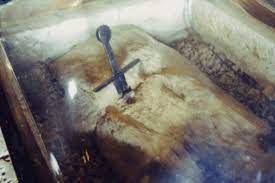Italy: Sword in the stone isn’t fake

Rome: At the Montesiepi Chapel in Siena, Italy, there is a strange artifact that will be instantly familiar to fans of Arthurian legend and anybody who has watched Disney’s The Sword in the Stone, being that it is a literal sword embedded inside a stone. According to a chemical analysis of the artifact, it is probably from the right time period rather than a recent fake.
The legend around the sword says that it was the weapon of Galgano Guidotti, a ruthless knight born in 1148 who went on to become a Catholic saint. According to the story – which largely comes from the canonization process which took place shortly after his death – Galgano’s father died early in Galgano’s childhood.
A rebellious child, Galgano fell in with a bad crowd. In today’s terms, that might mean people doing drugs, but at the time this meant participating “very eagerly in internal wars led by local lords of Gherardesca, Pannocchieschi and others, shedding blood of his neighbors”.

Galgano continued in this way for years, relishing the violence, before one day falling off his horse and having a religious revelation, converting shortly afterward to Christianity. According to legend, he abandoned his fiance and began a hermit’s life, all the while being served visions nagging at him to build a hermitage of his own.
Galgano was said to have thrust his old sword into the stone, a symbol of how he was abandoning his violent life. Rather than acting like a rock, it “yielded like butter” according to versions of the legend, leaving the hilt protruding from the top and the tip poking out the other end of the rock. Since then, the sword has remained in the stone, now housed inside the Rotunda in Siena, Tuscany.
As nonsensical as that sounds, there is a bit of a curveball coming up – in the form of scientific analysis. In 2001, chemist Luigi Garlaschelli examined the artifact and found a number of surprising details, while dispelling the myth that the sword was a recent fake.
“The style of the sword is consistent with that of other similar weapons from the same time,” Garlaschelli wrote at the time, “we can even label it as an Xa-type sword, typical of the late twelfth century”.
Garlaschelli retrieved samples of the sword from within the rock via a hole drilled into it and submitted them for analysis.
“Although iron artifacts cannot be unequivocally dated,” he wrote, “the composition of the metal did not reveal that modern alloys had been used, and so it is fully compatible with a medieval origin”.
Further analysis added weight to the sword being an authentic artifact from the time of Galgano’s life.
“We compared the ‘fingerprints’ of trace elements within the sword’s metal with that of pieces of iron slag that can still be found around the great abbey of St. Galgano. This slag is the waste from the small foundries used by the monks to manufacture their small iron objects, using local iron ore,” Garlaschelli explained.
Weirder still, a pair of mummified arms held near the sword – said to be those of thieves who had tried to take the stone, before being struck down by god ~ were also carbon-dated back to the 12th century. Meanwhile, it was also determined that the hilt protruding out of the rock and the sword blade underneath are one piece.
As annoying as it is, it remains a mystery precisely how the sword got in there, beyond vague legends that the stone somehow turned into butter.





